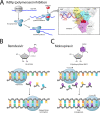SARS-CoV-2 Antiviral Therapy
- PMID: 34319150
- PMCID: PMC8404831
- DOI: 10.1128/CMR.00109-21
SARS-CoV-2 Antiviral Therapy
Abstract
The development of effective antiviral therapy for COVID-19 is critical for those awaiting vaccination, as well as for those who do not respond robustly to vaccination. This review summarizes 1 year of progress in the race to develop antiviral therapies for COVID-19, including research spanning preclinical and clinical drug development efforts, with an emphasis on antiviral compounds that are in clinical development or that are high priorities for clinical development. The review is divided into sections on compounds that inhibit SARS-CoV-2 enzymes, including its polymerase and proteases; compounds that inhibit virus entry, including monoclonal antibodies; interferons; and repurposed drugs that inhibit host processes required for SARS-CoV-2 replication. The review concludes with a summary of the lessons to be learned from SARS-CoV-2 drug development efforts and the challenges to continued progress.
Keywords: SARS-CoV-2; antiviral therapy; drug repurposing; monoclonal antibody; nucleoside analogs.
Figures




Similar articles
-
Antiviral Activity of Type I, II, and III Interferons Counterbalances ACE2 Inducibility and Restricts SARS-CoV-2.mBio. 2020 Sep 10;11(5):e01928-20. doi: 10.1128/mBio.01928-20. mBio. 2020. PMID: 32913009 Free PMC article.
-
Nucleoside Analogs That Inhibit SARS-CoV-2 Replication by Blocking Interaction of Virus Polymerase with RNA.Int J Mol Sci. 2023 Feb 8;24(4):3361. doi: 10.3390/ijms24043361. Int J Mol Sci. 2023. PMID: 36834771 Free PMC article.
-
Coronavirus Antiviral Research Database (CoV-RDB): An Online Database Designed to Facilitate Comparisons between Candidate Anti-Coronavirus Compounds.Viruses. 2020 Sep 9;12(9):1006. doi: 10.3390/v12091006. Viruses. 2020. PMID: 32916958 Free PMC article.
-
Pharmacological therapies and drug development targeting SARS-CoV-2 infection.Cytokine Growth Factor Rev. 2022 Dec;68:13-24. doi: 10.1016/j.cytogfr.2022.10.003. Epub 2022 Oct 13. Cytokine Growth Factor Rev. 2022. PMID: 36266222 Free PMC article. Review.
-
Antiviral Therapy of COVID-19.Int J Mol Sci. 2023 May 16;24(10):8867. doi: 10.3390/ijms24108867. Int J Mol Sci. 2023. PMID: 37240213 Free PMC article. Review.
Cited by
-
Current Treatments for COVID-19: Application of Supercritical Fluids in the Manufacturing of Oral and Pulmonary Formulations.Pharmaceutics. 2022 Nov 4;14(11):2380. doi: 10.3390/pharmaceutics14112380. Pharmaceutics. 2022. PMID: 36365198 Free PMC article. Review.
-
Antigens from the Helminth Fasciola hepatica Exert Antiviral Effects against SARS-CoV-2 In Vitro.Int J Mol Sci. 2023 Jul 18;24(14):11597. doi: 10.3390/ijms241411597. Int J Mol Sci. 2023. PMID: 37511355 Free PMC article.
-
Exploring diverse reactive warheads for the design of SARS-CoV-2 main protease inhibitors.Eur J Med Chem. 2023 Nov 5;259:115667. doi: 10.1016/j.ejmech.2023.115667. Epub 2023 Jul 19. Eur J Med Chem. 2023. PMID: 37482021 Free PMC article.
-
A solution to achieve sequencing from SARS-CoV-2 specimens with low viral loads: concatenation of reads from independent reactions.Virol J. 2024 May 30;21(1):121. doi: 10.1186/s12985-024-02347-5. Virol J. 2024. PMID: 38816844 Free PMC article.
-
Druggable targets and therapeutic development for COVID-19.Front Chem. 2022 Oct 5;10:963701. doi: 10.3389/fchem.2022.963701. eCollection 2022. Front Chem. 2022. PMID: 36277347 Free PMC article. Review.
References
Publication types
MeSH terms
Substances
Grants and funding
LinkOut - more resources
Full Text Sources
Medical
Miscellaneous

